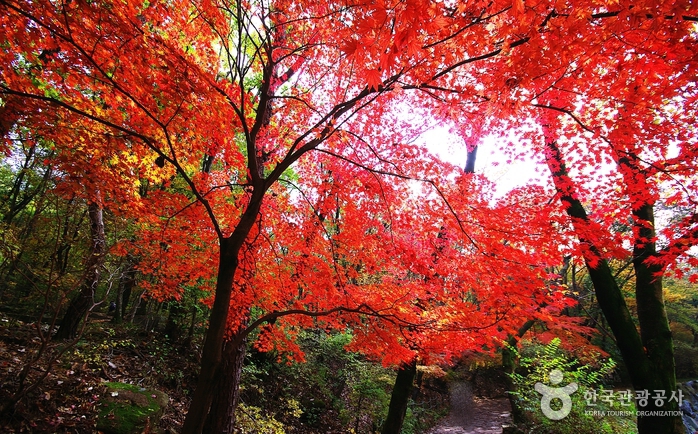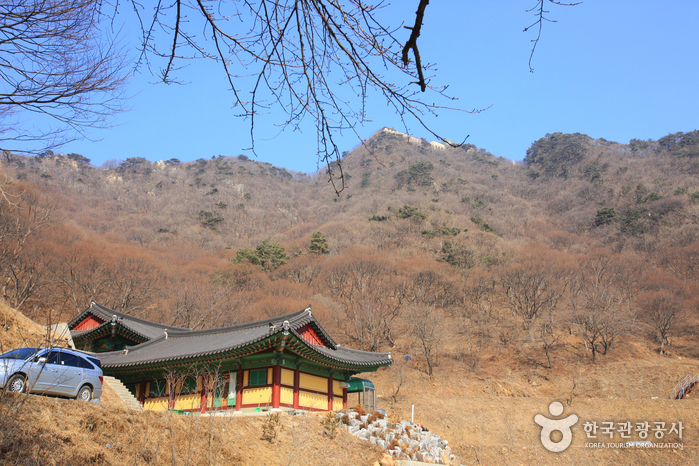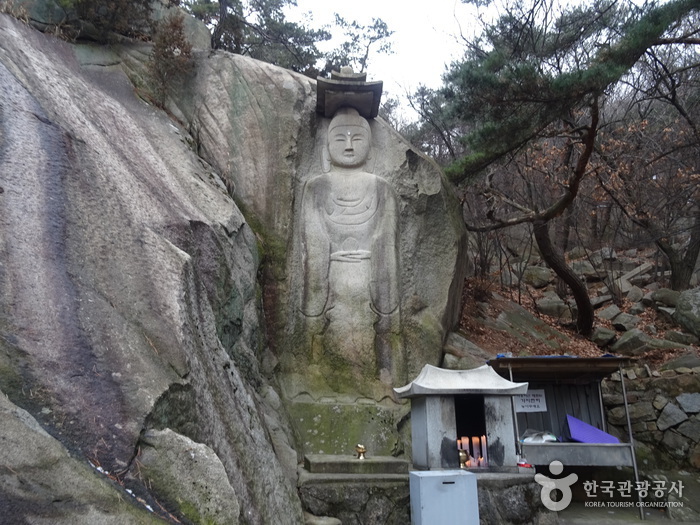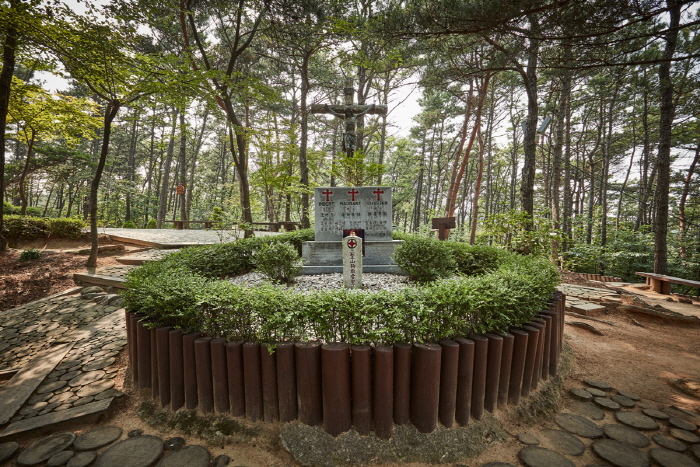Gwanaksan Mountain (관악산)
6.1Km 2023-01-02
Gwanak-ro, Gwanak-gu, Seoul
+82-2-879-6521
Reaching 632.2 meters in x_height, Gwanaksan Mountain is the symbol and pride of Gwanak-gu district in Seoul. Most of the cultural heritage of the district originates from Gwanaksan Mountain. Since it was designated as a city natural park in 1968, it has continued to serve as a favorite place for relaxation and excursion for Seoul citizens. The various rocky peaks and the deep valleys give the mountain a rugged feel. The mountain's size and close proximity to Seoul make it easy for Seoul residents to make a day trip.
In the spring, cherry blossoms are in full bloom near the entrance to the mountain, and a Rhododendron Festival is held when the rhododendrons are in full bloom. At the mountain's summit are Wongaksa Temple and Yeonjuam Hermitage, which were built by Taejo Yi Seong-gye (the founder of the Joseon dynasty) to ward off misfortune when he decided to move the capital to Seoul. There are also other temples and hermitages, and a ground radar observation post. Yeonjudae Hermitage, located atop a cliff, is where all the hiking trails of Gwanaksan Mountain meet.
Homeplus Stores - Siheung Branch [Tax Refund Shop] (홈플러스스토어즈 시흥)
6.1Km 2024-04-22
201, Siheung-daero, Geumcheon-gu, Seoul
-
Olive Young - Homeplus Siheung Branch [Tax Refund Shop] (올리브영 홈플러스시흥)
6.1Km 2024-04-18
1F, 201, Siheung-daero, Geumcheon-gu, Seoul
-
Surisan Provincial Park (수리산도립공원)
6.1Km 2025-01-08
347-4, Sokdal-ro, Gunpo-si, Gyeonggi-do
+82-31-808-8265
Surisan Mountain, a provincial park of Gyeonggi-do, surrounds Gunpo and is also easily accessible from Anyang and Ansan. Surisan Mountain is said to be named because there is a rock in the shape of an eagle. Another legend says it is named after the nearby Surisa Temple.
Surisan Mountain is part of the Gwangju Mountain Range along with Cheonggyesan, Gwanggyosan, Gwanaksan, and Baekunsan mountains. The mountain has four peaks and the highest is Taeulbong Peak (489 m).
Grand old trees that range from 100 to 300 years old make for picturesque scenery. The mountain also won first place in the 2002 Beautiful Forest contest hosted by the Korea Forest Service.
Jaunam Hermitage (자운암)
6.1Km 2023-05-08
Gwanak-ro, Gwanak-gu, Seoul
+82-2-882-3839
Jaunam Hermitage was originally built in 1396 by Great Monk Muhak of Joseon dynasty. It was renovated in 1734, and finally took shape of the hermitage we know today in 1976 when Monk Boryun added Daeungjeon Hall, Chilseonggak Pavilion, and Sansigak Pavilion. It is currently located in the famous Jahadong Valley on the Seoul National University campus.
Himart - Uiwang Branch [Tax Refund Shop] (하이마트 의왕점)
6.1Km 2024-04-18
365, Gyeongsu-daero, Uiwang-si, Gyeonggi-do
-
E-Mart - Gwangmyeong Soha Branch [Tax Refund Shop] (이마트 광명소하)
6.2Km 2024-04-22
97, Soha-ro, Gwangmyeong-si, Gyeonggi-do
-
Olive Young - Siheung Sageori Branch [Tax Refund Shop] (올리브영 시흥사거리)
6.3Km 2024-04-22
228, Siheung-daero, Geumcheon-gu, Seoul
-
1001 Optics [Tax Refund Shop] (1001안경콘택트)
6.3Km 2024-06-27
231, Siheung-daero, Geumcheon-gu, Seoul
-
Samseongsan Holy Ground (삼성산성지)
6.3Km 2021-08-17
454-16, Hoam-ro, Gwanak-gu, Seoul
+82-2-875-2271
During the Gihae Persecution of 1839, three French Catholic priests were sentenced to death for spreading Catholicism in Korea. Saint Laurent Joseph Marius Imbert (Bishop), Saint Pierre Philibert Maubant (Priest), and Saint Jacques Honore Chastan (Priest) were beheaded on September 21, 1839 at Saenamteo, currently known as the Saenamteo Catholic Holy Place of the Martyrs, and their bodies were buried at Samseongsan Mountain and later transferred to the grotto of Myeondong Cathedral.

![Homeplus Stores - Siheung Branch [Tax Refund Shop] (홈플러스스토어즈 시흥)](http://tong.visitkorea.or.kr/cms/resource/52/2880452_image2_1.jpg)
![Olive Young - Homeplus Siheung Branch [Tax Refund Shop] (올리브영 홈플러스시흥)](http://tong.visitkorea.or.kr/cms/resource/55/2880455_image2_1.jpg)



![E-Mart - Gwangmyeong Soha Branch [Tax Refund Shop] (이마트 광명소하)](http://tong.visitkorea.or.kr/cms/resource/38/2881838_image2_1.jpg)
![Olive Young - Siheung Sageori Branch [Tax Refund Shop] (올리브영 시흥사거리)](http://tong.visitkorea.or.kr/cms/resource/48/2880448_image2_1.jpg)

 English
English
 한국어
한국어 日本語
日本語 中文(简体)
中文(简体) Deutsch
Deutsch Français
Français Español
Español Русский
Русский